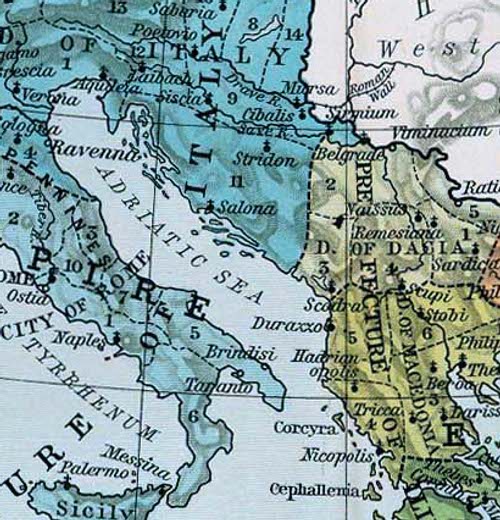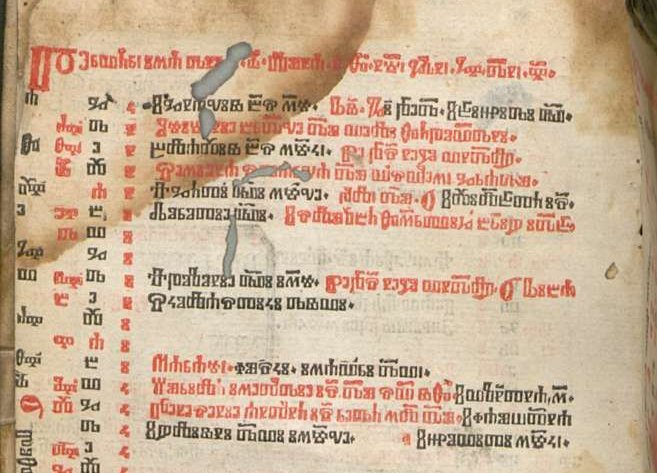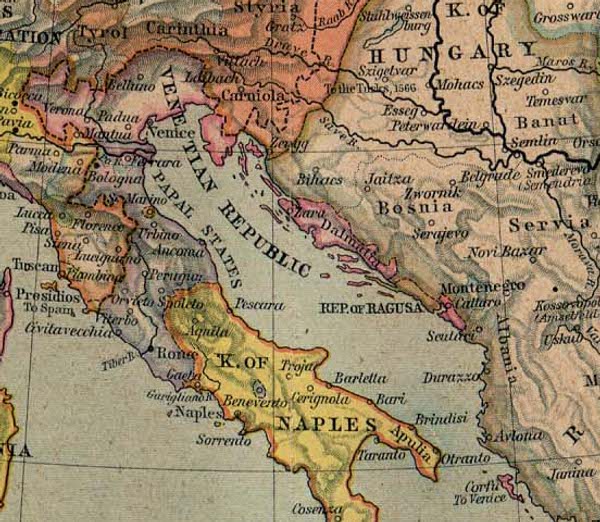From Croatian into Latin in 1510: Marko Marulić, Regum Delmatię atque Croatię gesta
A paper for the
Cambridge Society for Neo-Latin Studies symposium
Neo-Latin and Translation in the Renaissance
(Clare College, Cambridge Monday 20 - Tuesday 21 September 2010)
Neven Jovanović
University of Zagreb
Abstract
In 1510 Marko Marulić (Marcus Marulus, 1450–1524), a humanist from the Dalmatian city of Split, translated from Croatian into Latin the so-called Hrvatska kronika (Croatian Chronicle). This is an excerpt from the Annals of the Priest of Doclea, a medieval and for the most part legendary origo gentis of the Slavs of Dalmatia. As the Annals were originally composed in Latin, the Croatian Chronicle was itself a translation (though Marulić did not know this). Marulić gave his version the title Regum Delmatię atque Croatię gesta, and in the preface made it clear that he aimed at a wider audience (“res… quam non solum nostrę uernaculę linguę gnari, sed etiam Latinę intelligant”). But there was a problem. For this task a verbum verbo reddere approach was simply not acceptable, because the resulting text would not have met the standards of humanist Latin. Therefore, if we compare the version Marulić made with its Croatian source, as well as with the Latin Urtext, we shall better understand what was necessary for an elegant literary Latin around 1500.
The paper
1. Croatia in the Middle Ages
Croatia is a small country across the Adriatic from Italy, comprising today a part of what was once the Roman province of Dalmatia, and a part of what was Pannonia. In late antiquity it was the area of contact between the Eastern and Western Roman Empire; in the Middle Ages, between the Romans (living in Latin cities on the coast) and the Slavs, as well as between the Eastern Orthodox and the Roman Church spheres of influence. From the 10th until the 12th century there existed an independent Croatian kingdom, embracing Roman Catholicism and recognized by the Pope. The kingdom was later forced into a union with Hungary, to be eventually divided among Venice, the Habsburgs, and the Ottoman empire; only the city state of Dubrovnik would achieve and retain relative autonomy.
Figures: Croatia and Dalmatia from the Crusades until 1550--1560.
2. Gesta regum Sclavorum
Medieval literature of the region was written in three languages: Latin, Old Church Slavonic (a “common Slavic” liturgical language created for newly christianized Slavs on early Byzantine models, written in Glagolitic script), and Croatian vernacular. Texts in Old Church Slavonic and the vernacular (the oldest dating from the twelfth century) were for the most part translated from Latin, Greek, sometimes Italian. The predominant narrative prose genres were religious: hagiography, exempla, vision literature.1)
What survives of Croatian medieval historical prose narrative is not much, five texts in all.2) One stands apart, both by its scope and its language. It is the anonymous Gesta regum Sclavorum (GRS, known also as the Annals of the priest of Doclea). While other histories centre on a particular city or a particular event, the Gesta regum Sclavorum are a genealogy of rulers of independent Croatian kingdom.
The GRS tell who were the princes and kings of the Slavs (whom they call Goths) as they invaded Dalmatia and Pannonia “in the lifetime of St Bernard”, later accepting Christianity and forming a state under the auspices of the Pope; furthermore, the GRS show which rulers were good and which ones bad, and what they did until the eleventh century, when, around the time of the Domesday Book, the Croats opposed to a Crusade murdered their last king, Zvonimir. Before his death the king cursed the Croats, and the curse brought about the loss of Croatian independence.
The Gesta regum Sclavorum is singular also for the fact that it survives both in Latin and Croatian version. The two are not identical: the Latin version is longer, but the Croatian one covers a more extended historical period (and includes the legend of the murder and the curse of Zvonimir). The authorship and date of the text have long been the subject of controversy. The Gesta regum Sclavorum could have been written by a churchman — residing in Split or Bar or both — anytime between the twelfth and fourteenth century, i. e. between the time of Geoffrey of Monmouth or Chrétien de Troyes, and the time of Dante, Petrarch, or Chaucer. The shorter version could have been written before or after the longer one, it could have been composed in Croatian from the start or translated from Latin, etc.
However, what we know for sure is that the shorter version — known as the Croatian Chronicle (CC) — was discovered in 1500 in a region near the Dalmatian city of Split, and that in 1510 the chronicle was translated into Latin by a local Renaissance humanist, Marko Marulić or Marcus Marulus, who is celebrated today as the founding father of Croatian literature. To his translation of the CC Marulić gave the title Regum Delmatię atque Croatię gesta (RDCG).3)
3. Marulić
From 1420 most Dalmatian cities — Šibenik, Zadar, Trogir, Split, Hvar, Kotor — were under the rule of Venice. The Stato da Mar brought to the cities protection from local warlords and market demand for goods “de partibus Sclavoniae”. Later on, with the steady encroachment of Ottoman power, Dalmatia will turn into a war zone racked by poverty and plague; but for a time the prospering economy enabled the cities, among other things, to offer their sons humanist education, to hire fine teachers, often Italian. The results were considerable: Croatian Humanism began already in the first decades of the 15th century. Marulić represents the full development of this humanism, when Croatian authors write in various prose and poetic genres, on a wide range of themes, in elegant Latin, Croatian, and Italian.
Born in Split in 1450, Marko Marulić was a descendant of an elite family, the eldest child of a father with strong humanist interests of his own.4) The earliest text by Marko Marulić that we can date was written in 1464, when he was fourteen years old; it was an epitaph for a married couple killed by the Turks.
As he set to work translating the Regum gesta in 1510, the sixty years old Marulić had already composed the Judita, the first epic in Croatian; completed on April 22, 1501, this retelling of a biblical story in six cantos was the work that brought Marulić the title of the founding father of Croatian literature. Moreover, Marulić already had behind him one of his Latin successes, the De institutione bene uiuendi per exempla sanctorum, first published in Venice, 1507, to be republished in at least 15 Latin editions during the 15th and 16th centuries, and translated, with numerous reprints, into Italian, German, Portuguese, French, Czech. His other main Latin work, the Euangelistarium, seven books of practical Christian ethics (1480–1500), awaited publication; it will be published in Venice in 1516, to go through 15 Latin editions, and be translated into Italian, Spanish, Flemish, and French (among others, the book will have two important English readers — Henry VIII, whose annotated copy survives, and Thomas More).5)
Marulić has had practice as a translator already before 1510. As far as we know, in 1507–1508 he has translated into Croatian the De Imitatione Christi by Thomas a Kempis. And immediately after the Regum gesta, in 1511, he will compose a version of Petrarch's canzone Vergine bella in Latin elegiac verse, to be printed as a supplement to the Euangelistarium.6) Finally, as a coda to his ambitious, but unpublished Biblical epic Dauidias (written during 1510–1517) Marulić will add a Latin hexameter translation of the Canto I from Dante's Inferno.7)
4. Regum Delmatię atque Croatię gesta
A foreword to the RDCG8) is a short letter addressed to Marulić's friend and fellow citizen Dmine Papalić (Dominicus Papalis); it was he who discovered the manuscript with the Croatian text and asked Marulić to translate it. The letter gives two reasons for the undertaking:
Res certe digna relatu et quam non solum nostrae uernaculae linguae gnari, sed etiam Latinae, intelligant. Ex hac enim historia et boni exemplum petere poterunt quod imitentur, et mali per quod sese corrigant.
Marulić felt that for the Latin text to achieve its twofold didactic purpose — to be informative (quam intelligant) and also moralistic (exemplum petere) — translators' intervention was necessary. So he acknowledges in a very short afterword to the translation:
Hucusque historiam uernaculo gentis nostrae sermone compositam uidi et quam potui diligenter fideliterque in Latinum transposui, nihil de sententia dimittens, licet aliqua de uerbis, quae superflua uidebantur, mutilans ne lectori oneri essent.
The translator says here only that he cut the superfluous words (the extent of this cutting is visible at once as we scroll down the Appendix 1). But, as we will see, the range of translation tactics is broader, the extent of the changes greater. Practically everywhere Marulić raises the cultural and stylistic levels of the text, bringing it closer to Renaissance humanist historiography.
This invites a larger question, the one that, I believe, makes research in Latin translation challenging. When a writer such as Marulić decided to transform a medieval chronicle into a piece of Renaissance humanist history, what were the choices he had to make? What stylistic and grammatical features did he perceive as characteristic of an elegant historical narrative in Latin?
To find the answer I will compare the Croatian Chronicle and Marulić's Regum Delmatię atque Croatię gesta. The comparison will be enhanced by the third point of the triangle: the longer version of the chronicle, the Gesta regum Sclavorum, which for the first 28 chapters reads mostly as a literal translation of the Croatian version (or vice versa). What we have here is an opportunity to watch medieval Latin get translated into medieval Croatian, and from there into an authorial, writerly Renaissance Latin.
Remarks on methods
A few words on “methods and materials”. The basis of my research is a comparison of three texts — GRS, CC, and RDCG — carried out in a spreadsheet, then transformed into an XML file for presentation and close inspection. Prominent linguistic features — that is, the ones that I noticed — were further explored in three text collections: Packard Humanities Institute (PHI) Latin Library texts, The CETEDOC Library of Christian Latin Texts (CLCLT), and the Croatiae auctores Latini (CroALa) collection.
5. A sample sentence
6. Some translation tactics
7. Conclusion
In 1510, Marko Marulić and his Dalmatian friends tried to present the Renaissance republic of letters with a testimony to the first four or five centuries of Croatian history. An ancient Croatian chronicle, discovered near Split a decade ago, was to be translated into Latin. Marulić approached this task with seriousness and dedication, but also with authorial verve. The differences we find comparing the original with the translation reveal that Marulić tried to make the Croatian Chronicle both a better read and a more convincing story for the educated public.
To achieve this, he used classicizing equivalents for medieval terms, such as “legiones” for “exercitus”, “centuriones” for Croatian “satnici”. By elegant variation he avoided repetition and by finding anaphoric pairs he embellished the ends of sentences. The condensed syntax delivered more information at a faster pace; the sentences were structured into clear and balanced periods, usually with participial phrases at the beginning; also, Marulić streamlined the narrative and made it more coherent, leaving out the boring bits and finding motives for the characters' actions.
All those interventions transformed the cultural level of the text (here it is useful to remember the thesis of “two Renaissance cultures”: the Latin one, which was based on the ethics and philosophy of ancient Rome, the Bible, and the Church Fathers; and the lay culture, based on the laws and commandments of Scripture).
Marulić as a translator usually did not tamper with this level: Thomas a Kempis's De imitatione Christi and anonymous Dicta Catonis are plain texts transferred into plain Croatian prose or verse; grand poetry of Dante and Petrarch remains grand in Latin verse. Parallells to what Marulić has done with the RDCG can be found only in what is usually regarded as his original work. In the Judith, Marulić tried to raise, or open, the entire Croatian language to the level of grand epic; in the Davidiad he turned the story — which is sacred, but still plain — into classicizing literature.
Behind the change of style in the Regum gesta it is tempting to imagine a certain political agenda. By making Croatian warlords and kings more like rulers out of Livy and Sallust, by providing continuity between the Romans and the Croatians, Marulić engages with the European tradition according to which language reflects the speaker's moral, character, and level of civilization, representing his people as “better” — that means, more civilized — than they would otherwise appear to be.
But there is another question, less political, that haunted me as I was reading the Regum Croatię atque Dalmatię gesta. We see and understand how Marulić transformed a Croatian text into an elegant Latin. Would we be able to do the same today?
The texts
Further reading (mostly in English)
See a list on BibSonomy.



